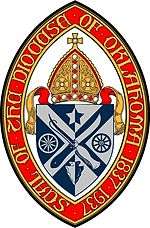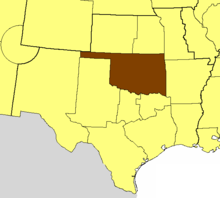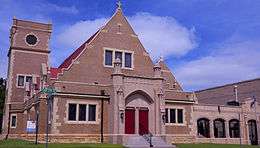Episcopal Diocese of Oklahoma
| Diocese of Oklahoma | |
|---|---|
 | |
| Location | |
| Ecclesiastical province | Province VII |
| Subdivisions | 6 Regions |
| Statistics | |
| Congregations | 69 (2014) |
| Members | 16,387 (2014) |
| Information | |
| Rite | Episcopal |
| Cathedral | St. Paul's Cathedral |
| Current leadership | |
| Bishop | Edward J. Konieczny |
| Map | |
 Location of the Diocese of Oklahoma | |
| Website | |
| www.episcopaloklahoma.org | |

The Episcopal Diocese of Oklahoma dates back to 1837 as a Missionary District of the Episcopal Church in the United States of America. The General Convention of the Episcopal Church recognized The Diocese of Oklahoma in 1937. The diocese consists of all Episcopal congregations in the state of Oklahoma. The eighth Bishop and fifth diocesan Bishop is Edward J. Konieczny, consecrated on September 15, 2007.
The see city is Oklahoma City, where St. Paul's Cathedral is located.
Institutions of the Diocese
- Ardmore Village, Ardmore
- St. Simeon's Episcopal Home, Tulsa
- St. Crispin's Conference Center, Wewoka
Supported schools
- Casady School, Oklahoma City
- Holland Hall, Tulsa
- Oak Hall Episcopal School, Ardmore
- St. Dunstan's Preschool, Tulsa
- St. John's Episcopal Preschool, Tulsa
- St. John's Episcopal School, Oklahoma City
- St. Mary's Episcopal School, Edmond
Previous bishops
Missionary/Eastern Oklahoma
Francis Key Brooke, 1893-1911 (1911-1919)
Elected bishop of the Missionary District of Oklahoma and Indian Territory on January 6, 1893, Brooke arrived in Guthrie on January 19 and established Trinity Church as his cathedral church until 1908, when he moved the diocesan headquarters to Oklahoma City.
Theodore Payne Thurston, (1911-1919) 1919-1926
An Illinois native, who served the church in Minnesota, Thurston was consecrated bishop of Eastern Oklahoma at Minneapolis in 1911. The previous year General Convention had divided the state into two dioceses. Thurston was socially liberal and a low churchman like Brooke. He chose Muskogee as his see city and Grace Church as his pro-cathedral.
The Convocation of the church in May 1919, after the death of Brooke, voted to recombine the two districts, and Thurston moved to Oklahoma City and St. Paul's. The move was approved by the national church in October.
Eugene Cecil Seaman, 1926-1927
Seaman had only recently been consecrated bishop of North Texas in 1925 when he was selected to serve as acting bishop of Oklahoma in 1926 because of the failing health of Thurston. He was a graduate of Sewanee, The University of the South, Tennessee. During his short service to the diocese, Seaman confirmed 270 persons, consecrated St. Paul's Cathedral, and smoothed the way for Casady to lead the state from a missionary district to a diocese.
Diocesan
Thomas Casady, 1927-1953
Thomas Casady was born in Des Moines, Iowa on June 6, 1881, the son of Simon Casady and Sarah Covarral. He was educated in the public schools of Des Moines and graduated from the University of Iowa in 1902.
His father, a banker, had hoped he would follow him in the banking business, but Thomas developed a vocation for Holy Orders. He was a member of the Sigma Chi fraternity, a Freemason, and a Knight Templar.
In 1903 he entered General Theological Seminary. After he became bishop he received an honorary doctorate of sacred theology from General Seminary and an honorary doctorate of divinity from Sewanee, The University of the South, Tennessee.
He was ordained deacon in June 1906, and priest in February 1907. On 27 June 1906 he married Frances LeBaron Kasson, by whom he had six children.
On October 2, 1927 at All Saints' Church, Omaha, Nebraska he was consecrated bishop by the Presiding Bishop, John Gardner Murray, Bishop of Maryland, assisted by Theodore N. Morrison, Bishop of Iowa; George A. Beecher, Bishop of Nebraska and a number of other bishops.
Casady was the third Missionary Bishop of Oklahoma and the first diocesan Bishop.
Frederick W. Putnam, Suffragan 1963-1979
Frederick Warren Putnam Jr. was born in Red Wing, Minnesota in 1917. He received his education in the public schools in Minneapolis and graduated from the University of Minnesota in 1939. That fall he entered Seabury-Western Theological Seminary, graduating with a bachelor of Theology in 1942. In March of that year he had been ordained Deacon and by October he became a priest. He married Helen Kathryn Prouse and they had three children. In November 1962 he was elected to be Oklahoma's first Suffragan Bishop.
Putnam died June 7, 2007[1]
Chilton Powell, 1953-1977
Chilton Powell was consecrated Bishop Coadjutor in 1951 and became the Bishop of Oklahoma after Casady’s retirement in 1953. At Powell’s election, there were 35 clergy and a Diocesan budget of $100,000.00. Powell is best remembered as a missionary Bishop. Under his care, the Diocese opened many new missions all over Oklahoma, including the panhandle as well as St Crispin's, a new conference center in Seminole. While Bishop of Oklahoma, Powell also chaired the Prayer Book Commission that produced the 1979 Prayer Book. At the end of his episcopate, there were 77 congregations, missions and parishes.
Gerald Nicholas McAllister, 1977-1989
Following the retirement of Powell, Gerald Nicholas McAllister became Bishop in 1977 and remained so until 1989 when Robert M. Moody was elected. During the time of McAllister, outreach became a priority. The Venture in Mission program raised 2.3 million dollars and committed half of that to overseas missions. The concept of total ministry became a Diocesan priority. Cluster ministries were instituted, hospital chaplains and college chaplains were added, two Episcopal schools flourished, and two residential facilities were opened for the elderly. At the end of McAllister’s time as bishop, the diocese was more financially sound and had grown to 80 congregations, missions, parishes, and two conference centers.
Robert M. Moody, 1989-2007
Robert Moody was elected as the bishop coadjutor on September 19, 1987 at St. Paul’s Cathedral on the first ballot. Upon the retirement of McAllister he became our fourth diocesan Bishop. He was committed to mission by pursuing an active ministry among the Native Americans with the appointment of an Indian missioner and the development of a center for Indian ministry in Watonga Oklahoma. On April 19, 1995 the Murrah building was destroyed by a bombing. Moody and the diocesan staff assisted in the evacuation of residents from a housing development across from the Diocesan offices, provided pastoral assistance in a nearby hospital, and in the days following the blast the distribution of over $500,000 to those in financial need as a result of the bombing.
Edward J. Konieczny, 2007-
The former rector of St. Matthew's Episcopal Church in Grand Junction, Colorado, Ed Konieczny was elected on the first ballot on May 5, 2007 at St. Paul's Cathedral. Konieczny was consecrated 5th bishop on September 15, 2007 at Oklahoma City University. Presiding Bishop Katharine Jefferts Schori was chief consecrator. Co-consecrators included Edward S. Little, II, Bishop of Northern Indiana; Robert M. Moody, retiring bishop of Oklahoma; and Robert J. O'Neill, Bishop of Colorado, who was the preacher.[2]
From 1975 until 1992, Konieczny served as a Police Officer in Garden Grove and Anaheim, CA. He was ordained a Deacon and Priest in 1994 with his Master of Divinity Degree from Church Divinity School of the Pacific, Berkeley, CA. He served churches in Texas and Colorado. In 2007, he received a Doctor of Divinity, honoris causa, for his work in the church from Seabury-Western Theological Seminary.
Konieczny and his wife, Debbie, have two sons and three grandchildren.
References
- ↑ "Bishops Stephen Jecko, Frederick Putnam die on same day" by Joe Bjordal and Mary Frances Schjonberg, EpiscopalLife, June 08, 2007, retrieved June 11, 2007
- ↑ OKLAHOMA: Edward Konieczny becomes fifth bishop Episcopal News Service, September 17, 2007.
Sources
Botkin, S. (1958). The Episcopal Church in Oklahoma, Oklahoma City: American-Bond Printing Company.
External links
- Official Website of the Diocese of Oklahoma
- St. Paul's Episcopal Cathedral
- Bishop Search Process
- Diocese of Oklahoma Cursillo Movement
- Diocese of Oklahoma ECW
- Vocare in Oklahoma
- Diocesan Constitution as revised 14 November 2003
- Diocesan Canons as revised 19 November 2005.
- Episcopal Church in the United States of America
- Journal of the Annual Convocation of the Missionary District of Oklahoma and Indian Territory
- Journal of the Annual Convocation of the Missionary District of Eastern Oklahoma
Coordinates: 35°28′31″N 97°30′57″W / 35.47528°N 97.51583°W